Abstract
Dihydrofolate reductase was partially purified from a pyrimethamine-sensitive Plasmodium chabaudi clone and a pyrimethamine-resistant clone derived from it and used in a study of the inhibitory effect of pyrimethamine and sulfadoxine, both alone and in combination. Kinetic analysis of the inhibitory effect of sulfadoxine against the enzyme from pyrimethamine-sensitive and -resistant parasites revealed that the drug inhibited the former enzyme competitively, with an inhibition constant (Kis) of 0.7 +/- 0.4 mM, but inhibited the latter enzyme noncompetitively, with Kis and Kii of 8.9 +/- 1.2 and 4.1 +/- 1.2 mM, respectively. Previous studies also showed competitive inhibition by pyrimethamine on the former enzyme and noncompetitive inhibition on the latter enzyme, with some 200-fold-lower affinity. Sulfadoxine and pyrimethamine exhibited a mutually potentiating effect on the enzyme activity, as revealed by the concave isoboles and the fractional inhibitions of less than unity. A potentiating effect was observed for the enzymes from both sources and was not dependent on the degree of the purification of the enzyme. Our results can be explained by assuming simultaneous binding of two inhibitors on the enzyme.
Full text
PDF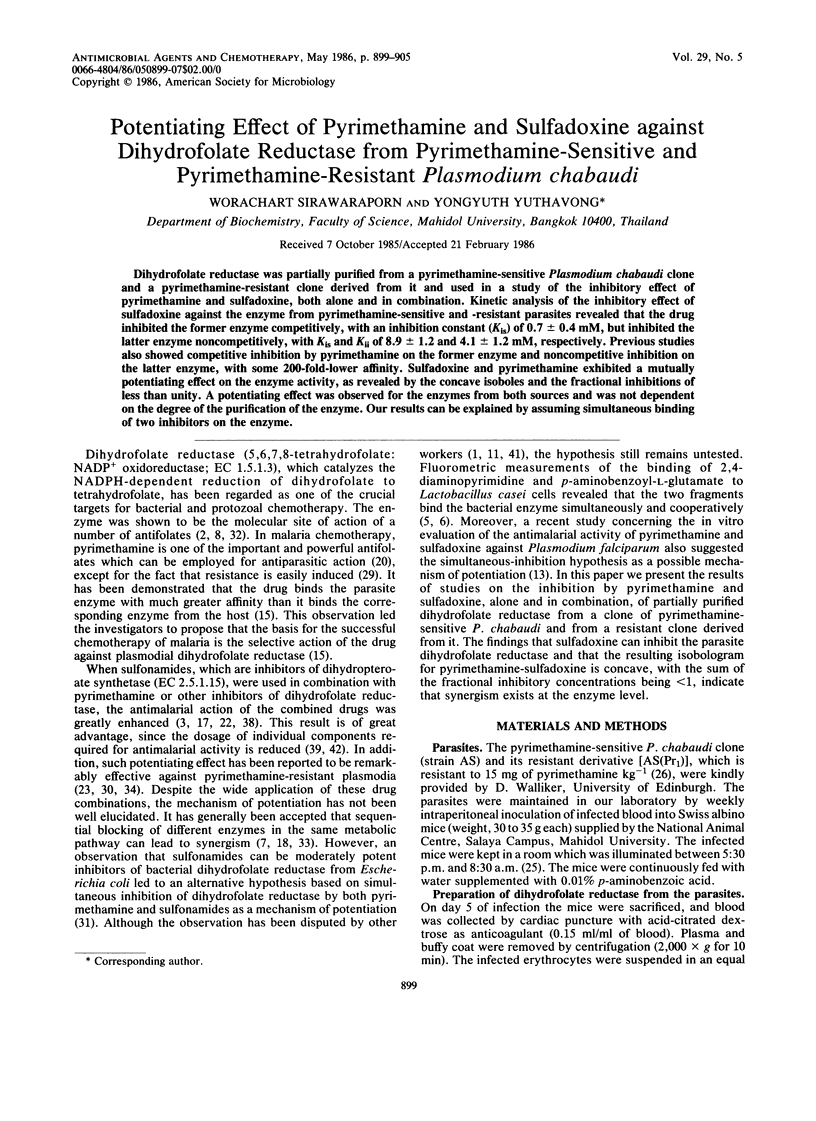
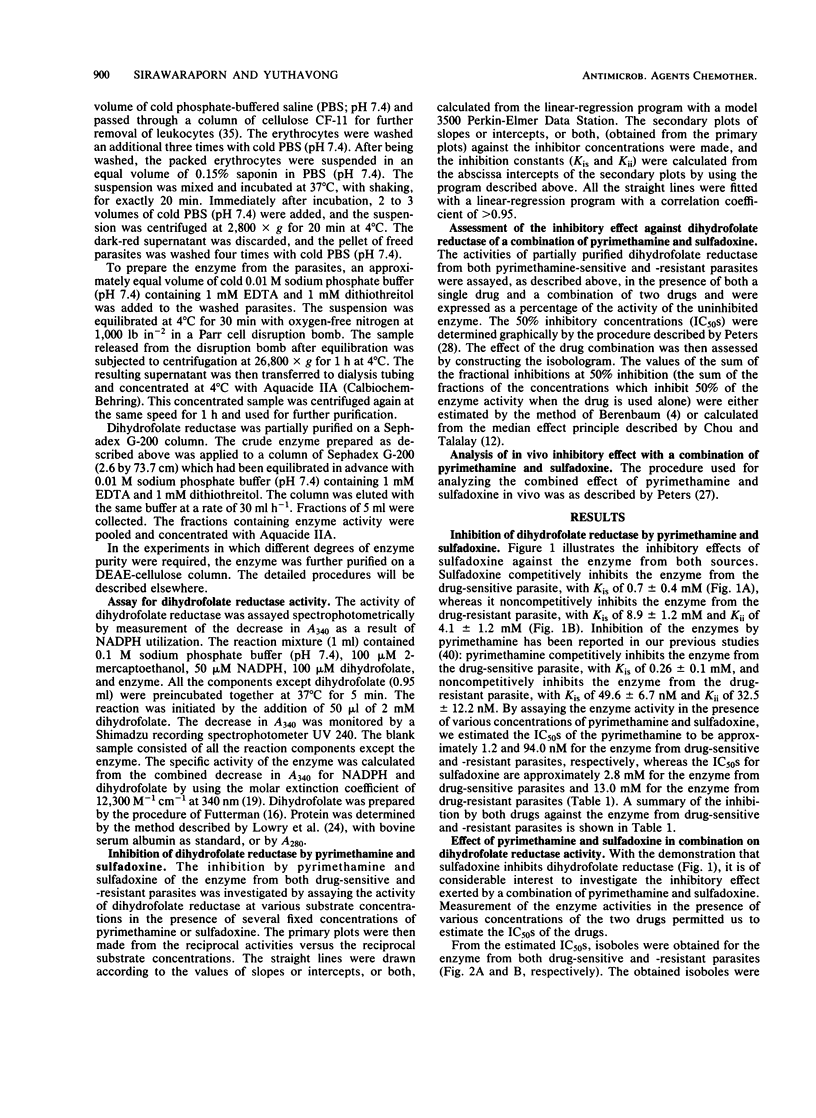
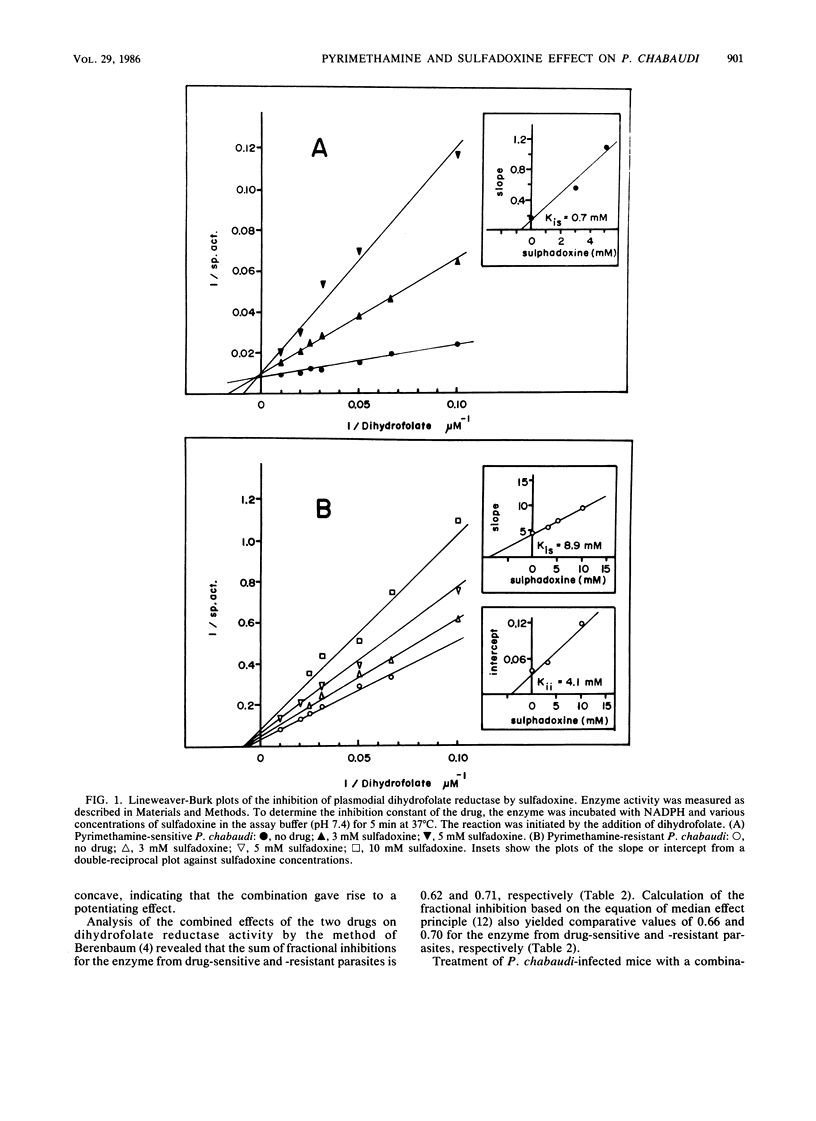
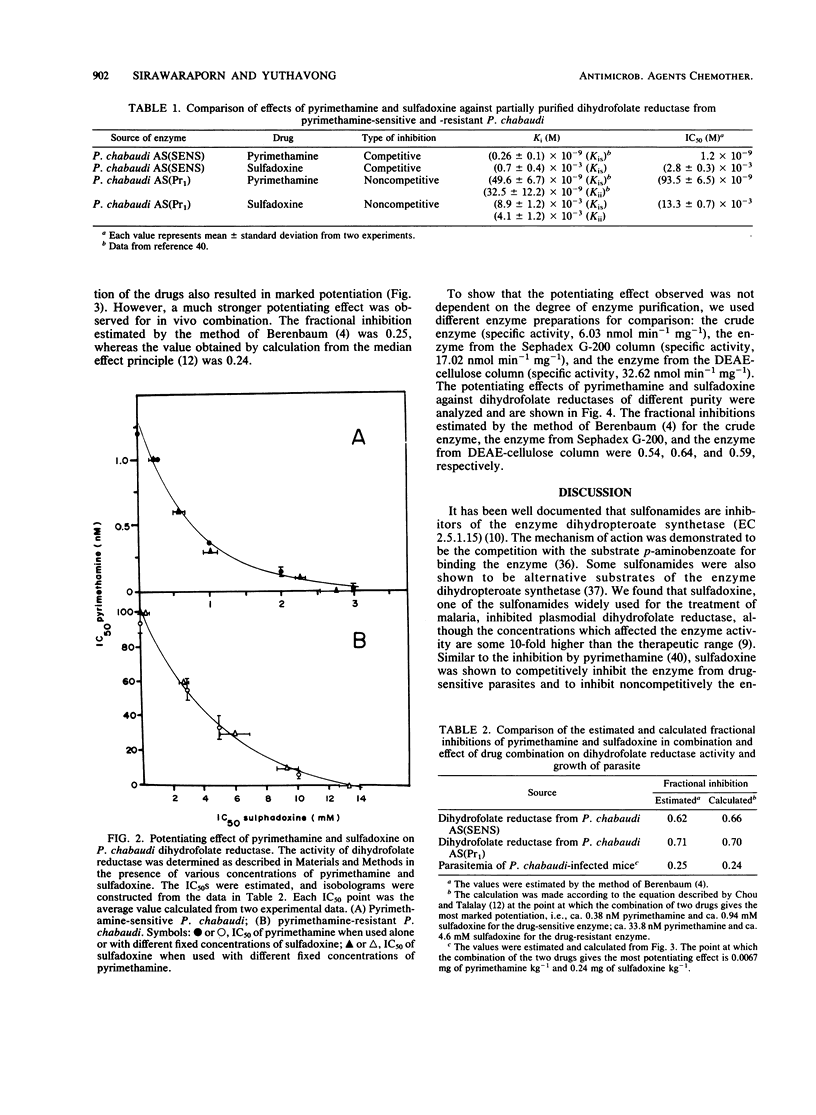
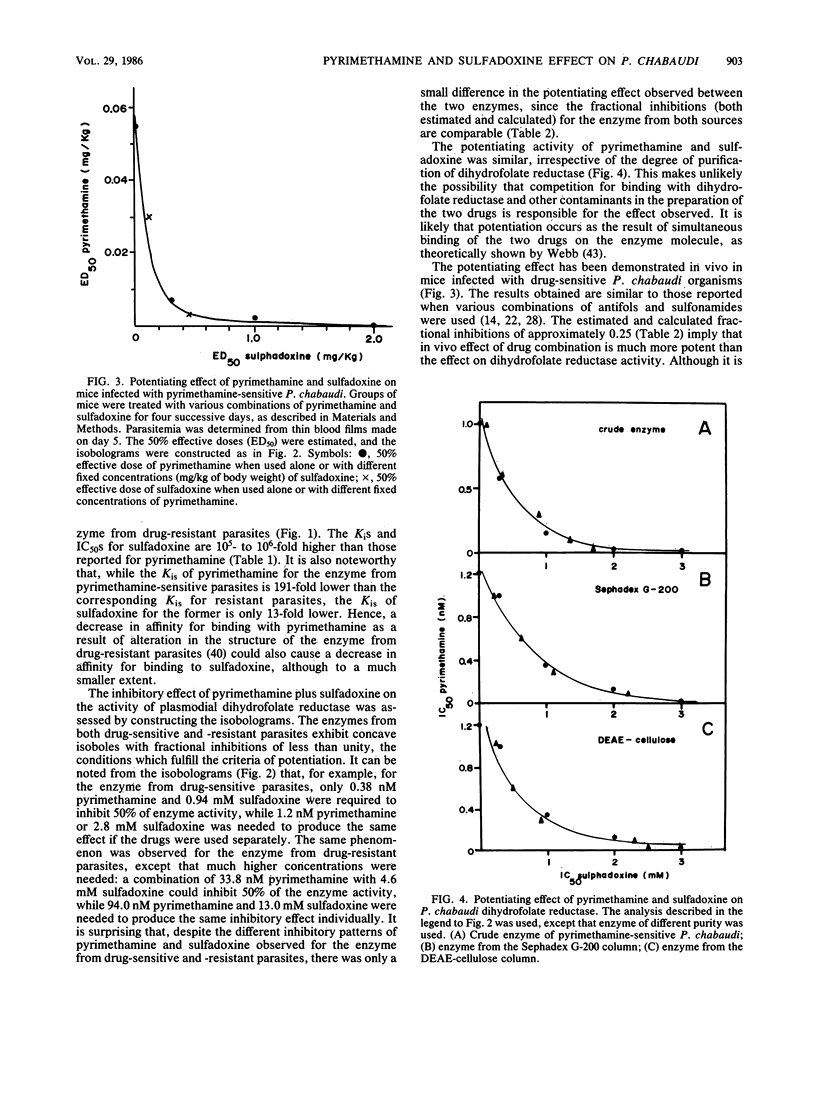
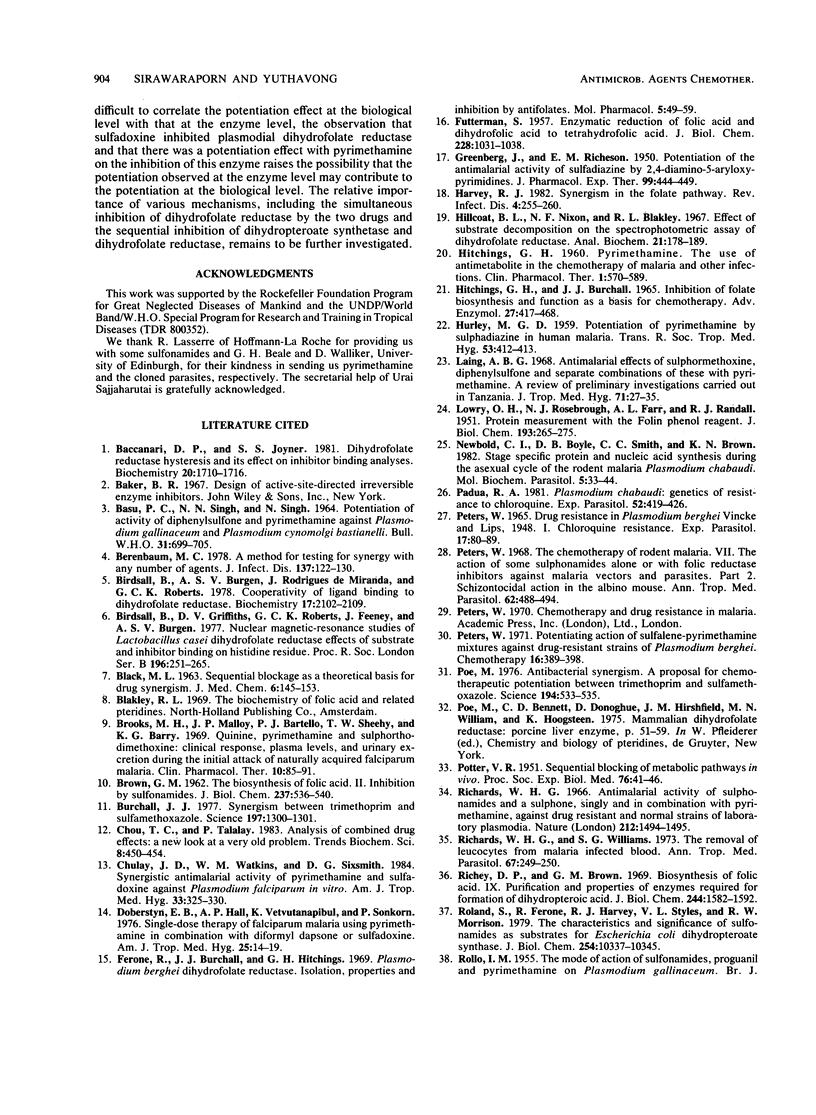
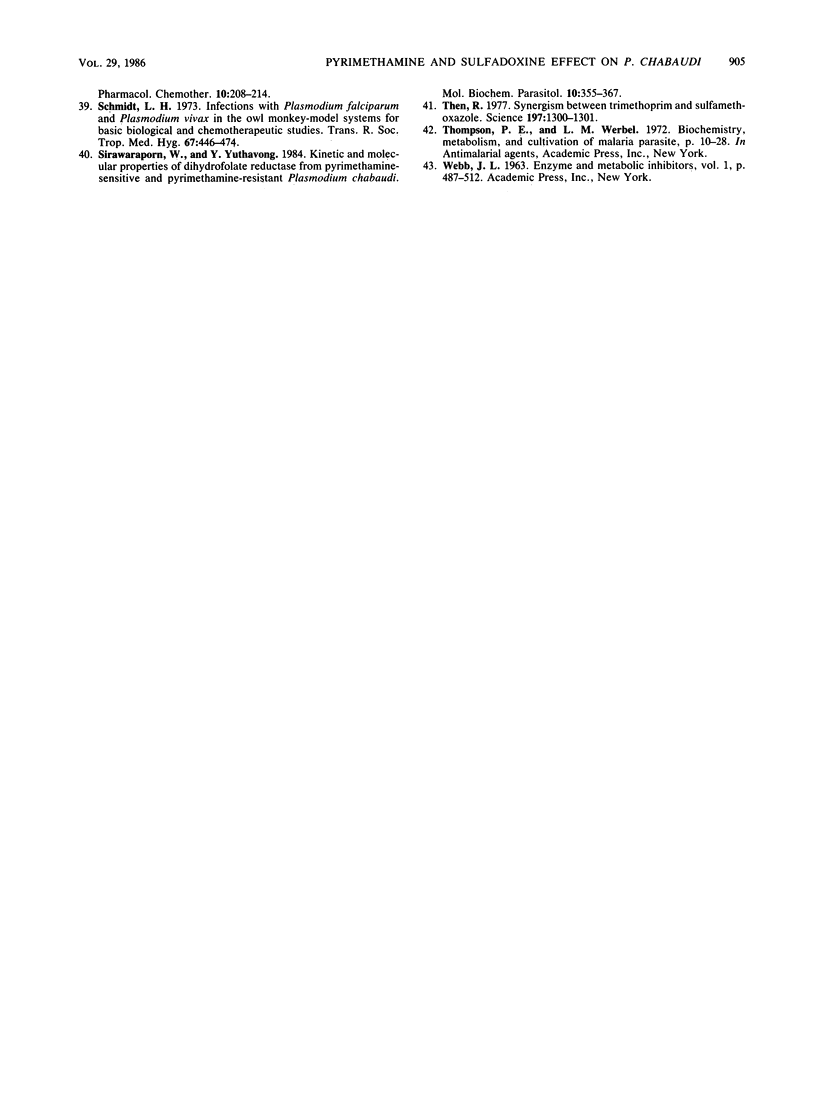
Selected References
These references are in PubMed. This may not be the complete list of references from this article.
- BASU P. C., SINGH N. N., SINGH N. POTENTIATION OF ACTIVITY OF DIAPHENYLSULFONE AND PYRIMETHAMINE AGAINST PLASMODIUM GALLINACEUM AND PLASMODIUM CYNOMOLGI BASTIANELLII. Bull World Health Organ. 1964;31:699–705. [PMC free article] [PubMed] [Google Scholar]
- BLACK M. L. SEQUENTIAL BLOCKAGE AS A THEORETICAL BASIS FOR DRUG SYNERGISM. J Med Chem. 1963 Mar;6:145–153. doi: 10.1021/jm00338a014. [DOI] [PubMed] [Google Scholar]
- BROWN G. M. The biosynthesis of folic acid. II. Inhibition by sulfonamides. J Biol Chem. 1962 Feb;237:536–540. [PubMed] [Google Scholar]
- Baccanari D. P., Joyner S. S. Dihydrofolate reductase hysteresis and its effect of inhibitor binding analyses. Biochemistry. 1981 Mar 31;20(7):1710–1716. doi: 10.1021/bi00510a002. [DOI] [PubMed] [Google Scholar]
- Berenbaum M. C. A method for testing for synergy with any number of agents. J Infect Dis. 1978 Feb;137(2):122–130. doi: 10.1093/infdis/137.2.122. [DOI] [PubMed] [Google Scholar]
- Birdsall B., Burgen A. S., Rodrigues de Miranda J., Roberts G. C. Cooperativity in ligand binding to dihydrofolate reductase. Biochemistry. 1978 May 30;17(11):2102–2110. doi: 10.1021/bi00604a013. [DOI] [PubMed] [Google Scholar]
- Birdsall B., Griffiths D. V., Roberts G. C., Feeney J., Burgen A. 1H nuclear magnetic resonance studies of Lactobacillus casei dihydrofolate reductase: effects of substrate and inhibitor binding on the histidine residues. Proc R Soc Lond B Biol Sci. 1977 Mar 18;196(1124):251–265. doi: 10.1098/rspb.1977.0040. [DOI] [PubMed] [Google Scholar]
- Brooks M. H., Malloy J. P., Bartelloni P. J., Sheehy T. W., Barry K. G. Quinine, pyrimethamine, and sulphorthodimethoxine: clinical response, plasma levels, and urinary excretion during the initial attack of naturally acquired falciparum malaria. Clin Pharmacol Ther. 1969 Jan-Feb;10(1):85–91. doi: 10.1002/cpt196910185. [DOI] [PubMed] [Google Scholar]
- Chulay J. D., Watkins W. M., Sixsmith D. G. Synergistic antimalarial activity of pyrimethamine and sulfadoxine against Plasmodium falciparum in vitro. Am J Trop Med Hyg. 1984 May;33(3):325–330. doi: 10.4269/ajtmh.1984.33.325. [DOI] [PubMed] [Google Scholar]
- Doberstyn E. B., Hall A. P., Vetvutanapibul K., Sonkon P. Single-dose therapy of Falciparum malaria using pyrimethamine in combination with diformyldapsone or sulfadoxine. Am J Trop Med Hyg. 1976 Jan;25(1):14–19. doi: 10.4269/ajtmh.1976.25.14. [DOI] [PubMed] [Google Scholar]
- FUTTERMAN S. Enzymatic reduction of folic acid and dihydrofolic acid to tetrahydrofolic acid. J Biol Chem. 1957 Oct;228(2):1031–1038. [PubMed] [Google Scholar]
- Ferone R., Burchall J. J., Hitchings G. H. Plasmodium berghei dihydrofolate reductase. Isolation, properties, and inhibition by antifolates. Mol Pharmacol. 1969 Jan;5(1):49–59. [PubMed] [Google Scholar]
- GREENBERG J., RICHESON E. M. Potentiation of the antimalarial activity of sulfadiazine by 2,4-diamino-5-aryloxypyrimidines. J Pharmacol Exp Ther. 1950 Aug;99(41):444–449. [PubMed] [Google Scholar]
- Harvey R. J. Synergism in the folate pathway. Rev Infect Dis. 1982 Mar-Apr;4(2):255–260. doi: 10.1093/clinids/4.2.255. [DOI] [PubMed] [Google Scholar]
- Hillcoat B. L., Nixon P. F., Blakley R. L. Effect of substrate decomposition on the spectrophotometric assay of dihydrofolate reductase. Anal Biochem. 1967 Nov;21(2):178–189. doi: 10.1016/0003-2697(67)90179-0. [DOI] [PubMed] [Google Scholar]
- Hitchings G. H., Burchall J. J. Inhibition of folate biosynthesis and function as a basis for chemotherapy. Adv Enzymol Relat Areas Mol Biol. 1965;27:417–468. doi: 10.1002/9780470122723.ch9. [DOI] [PubMed] [Google Scholar]
- LOWRY O. H., ROSEBROUGH N. J., FARR A. L., RANDALL R. J. Protein measurement with the Folin phenol reagent. J Biol Chem. 1951 Nov;193(1):265–275. [PubMed] [Google Scholar]
- Laing A. B. Antimalarial effects of sulphormethoxine, diaphenylsulphone and separate combinations of these with pyrimethamine: a review of preliminary investigations carried out in Tanzania. J Trop Med Hyg. 1968 Feb;71(2):27–35. [PubMed] [Google Scholar]
- Newbold C. I., Boyle D. B., Smith C. C., Brown K. N. Stage specific protein and nucleic acid synthesis during the asexual cycle of the rodent malaria Plasmodium chabaudi. Mol Biochem Parasitol. 1982 Jan;5(1):33–44. doi: 10.1016/0166-6851(82)90004-4. [DOI] [PubMed] [Google Scholar]
- POTTER V. R., SIMONSON H. Sequential blocking of metabolic pathways in vivo. Proc Soc Exp Biol Med. 1951 Jan;76(1):41–46. doi: 10.3181/00379727-76-18383. [DOI] [PubMed] [Google Scholar]
- Padua R. A. Plasmodium chabaudi: genetics of resistance to chloroquine. Exp Parasitol. 1981 Dec;52(3):419–426. doi: 10.1016/0014-4894(81)90101-6. [DOI] [PubMed] [Google Scholar]
- Peters W. Drug resistance in Plasmodium berghei Vincke and Lips, 1948. I. Chloroquine resistance. Exp Parasitol. 1965 Aug;17(1):80–89. doi: 10.1016/0014-4894(65)90012-3. [DOI] [PubMed] [Google Scholar]
- Peters W. Potentiating action of sulfalene-pyrimethamine mixtures against drug-resistant strains of Plasmodium berghei. Chemotherapy. 1971;16(6):389–398. doi: 10.1159/000220753. [DOI] [PubMed] [Google Scholar]
- Peters W. The chemotherapy of rodent malaria. VII. The action of some sulphonamides alone or with folic reductase inhibitors against malaria vectors and parasites, 2: schizontocidal action in the albino mouse. Annu Rev Pharmacol. 1968 Dec;62(4):488–494. [PubMed] [Google Scholar]
- Poe M. Antibacterial synergism: a proposal for chemotherapeutic potentiation between trimethoprim and sulfamethoxazole. Science. 1976 Oct 29;194(4264):533–535. doi: 10.1126/science.788154. [DOI] [PubMed] [Google Scholar]
- ROLLO I. M. The mode of action of sulphonamides, proguanil and pyrimethamine on Plasmodium gallinaceum. Br J Pharmacol Chemother. 1955 Jun;10(2):208–214. doi: 10.1111/j.1476-5381.1955.tb00084.x. [DOI] [PMC free article] [PubMed] [Google Scholar]
- Richards W. H., Williams S. G. The removal of leucocytes from malaria infected blood. Ann Trop Med Parasitol. 1973 Jun;67(2):249–250. doi: 10.1080/00034983.1973.11686885. [DOI] [PubMed] [Google Scholar]
- Richey D. P., Brown G. M. The biosynthesis of folic acid. IX. Purification and properties of the enzymes required for the formation of dihydropteroic acid. J Biol Chem. 1969 Mar 25;244(6):1582–1592. [PubMed] [Google Scholar]
- Roland S., Ferone R., Harvey R. J., Styles V. L., Morrison R. W. The characteristics and significance of sulfonamides as substrates for Escherichia coli dihydropteroate synthase. J Biol Chem. 1979 Oct 25;254(20):10337–10345. [PubMed] [Google Scholar]
- Schmidt L. H. Infections with Plasmodium falciparum and Plasmodium vivax in the owl monkey--model systems for basic biological and chemotherapeutic studies. Trans R Soc Trop Med Hyg. 1973;67(4):446–474. doi: 10.1016/0035-9203(73)90077-1. [DOI] [PubMed] [Google Scholar]
- Sirawaraporn W., Yuthavong Y. Kinetic and molecular properties of dihydrofolate reductase from pyrimethamine-sensitive and pyrimethamine-resistant Plasmodium chabaudi. Mol Biochem Parasitol. 1984 Mar;10(3):355–367. doi: 10.1016/0166-6851(84)90033-1. [DOI] [PubMed] [Google Scholar]


